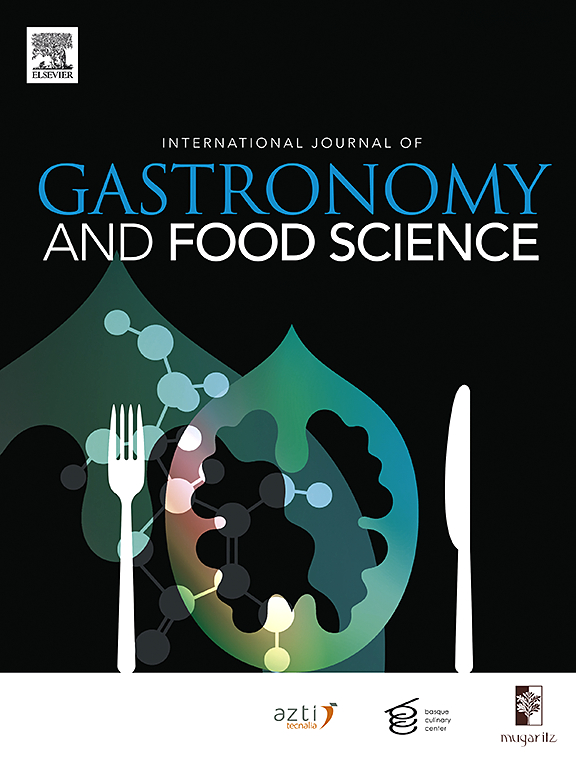结合酶处理的老化方法对牛里脊肉质量参数的影响
IF 3.2
2区 农林科学
Q2 FOOD SCIENCE & TECHNOLOGY
International Journal of Gastronomy and Food Science
Pub Date : 2024-11-09
DOI:10.1016/j.ijgfs.2024.101056
引用次数: 0
摘要
本研究的目的是评估不同酶(木瓜蛋白酶、菠萝蛋白酶和真菌蛋白酶)处理和老化方法(干式老化和湿式老化)在 28 天老化期间对牛肉条的理化和微生物参数、脂质氧化、肉筋长度、色泽、剪切力和感官属性的综合影响。为此,对宰后 24 小时的腰长肌肌肉(n = 24,12 块胴体)在酶处理后分别采用干法(2 ± 1 °C,相对湿度 75%,气流速度 2m/s)和湿法(真空包装,2 ± 1 °C)进行老化。湿法陈化牛肉的微生物生长(P < 0.05)和脂质氧化(P < 0.001)均低于干法陈化牛肉,经真菌蛋白酶处理的牛肉微生物生长和脂质氧化均有所下降(P < 0.05),而干法陈化牛肉的肌节长度和持水能力有所增加,蒸煮损失有所减少(P < 0.001)。干法老化与木瓜蛋白酶结合使用可在缩短老化时间的同时增强和加速肉质嫩化(P < 0.001),而菠萝蛋白酶和真菌蛋白酶处理可改善风味和香气。干牛肉和湿牛肉的表面颜色在老化期间有显著差异(P < 0.05),而经过酶处理的带肋牛肉的 b∗、h∗ 值和高铁血红蛋白含量较低。因此,将老化方法与酶处理结合使用,可以有效改善牛肉的嫩度和适口性,并缩短老化时间,为肉类行业提供了一个在更短时间内供应高附加值牛肉的机会。本文章由计算机程序翻译,如有差异,请以英文原文为准。
Effects of aging methods combined with enzyme treatments on the quality parameters of beef striploins
The objective of this study was to evaluate the combined effects of different enzyme (papain, bromelain and fungal protease) treatments and aging methods (dry and wet aging) on physico-chemical and microbiological parameters, lipid oxidation, sarcomere length, colour, shear force and sensory attributes of beef striploins during 28-day aging period. For this purpose, Longissimus lumborum muscles (n = 24, 12 carcasses) at 24h postmortem were subjected to dry (2 ± 1 °C, 75% relative humidity and 2m/s air-flow) and wet (vacuum-packaged, 2 ± 1 °C) aging methods after enzyme treatments. The microbial growth (P < 0.05) and lipid oxidation (P < 0.001) in wet-aged beef were lower than dry-aged beef, and a decrease in those treated with fungal protease was observed (P < 0.05), while an increase in sarcomere length and water holding capacity, and a decrease in cooking losses were provided with dry aging (P < 0.001). Dry aging combined with papain enzyme enhanced and accelerated meat tenderization in a reduced aging time (P < 0.001), whereas an improvement in flavour and aroma was achieved with bromelain and fungal protease treatments. Surface colour of dry and wet-aged beef showed significant differences during aging period (P < 0.05), while lower b∗, h∗ values and metmyoglobin content were recorded in enzyme-treated striploins. Consequently, combined usage of aging methods with enzyme treatments can be preferred as an effective application to improve the tenderness and palatability of beef with accelerated aging period, and provides an opportunity for meat industry to supply value adding beef in a shorter time.
求助全文
通过发布文献求助,成功后即可免费获取论文全文。
去求助
来源期刊

International Journal of Gastronomy and Food Science
Social Sciences-Cultural Studies
CiteScore
5.30
自引率
10.50%
发文量
170
审稿时长
45 days
期刊介绍:
International Journal of Gastronomy and Food Science is a peer-reviewed journal that explicitly focuses on the interface of food science and gastronomy. Articles focusing only on food science will not be considered. This journal equally encourages both scientists and chefs to publish original scientific papers, review articles and original culinary works. We seek articles with clear evidence of this interaction. From a scientific perspective, this publication aims to become the home for research from the whole community of food science and gastronomy.
IJGFS explores all aspects related to the growing field of the interaction of gastronomy and food science, in areas such as food chemistry, food technology and culinary techniques, food microbiology, genetics, sensory science, neuroscience, psychology, culinary concepts, culinary trends, and gastronomic experience (all the elements that contribute to the appreciation and enjoyment of the meal. Also relevant is research on science-based educational programs in gastronomy, anthropology, gastronomic history and food sociology. All these areas of knowledge are crucial to gastronomy, as they contribute to a better understanding of this broad term and its practical implications for science and society.
 求助内容:
求助内容: 应助结果提醒方式:
应助结果提醒方式:


